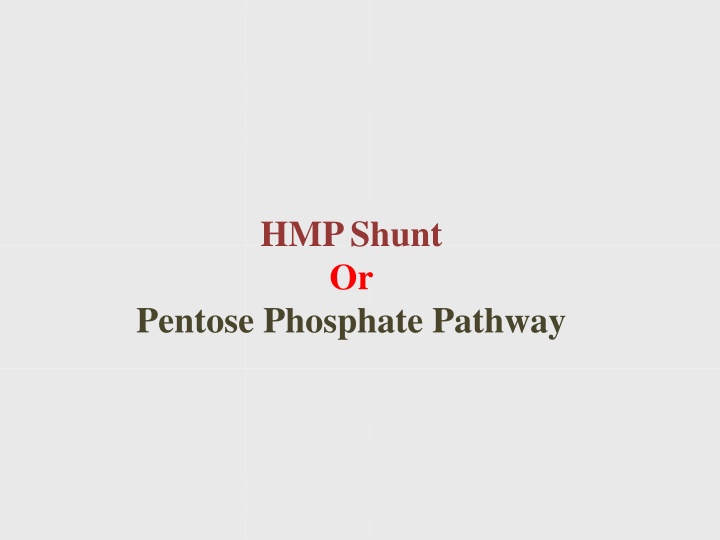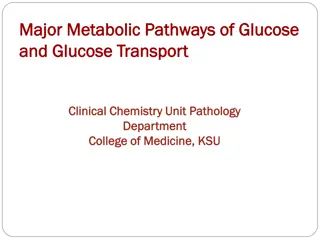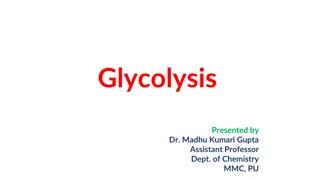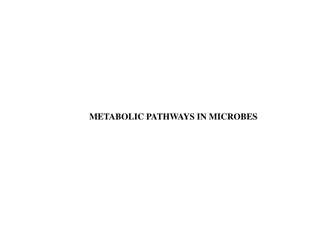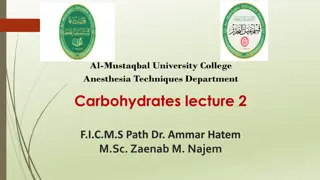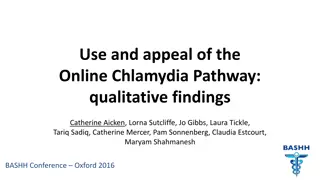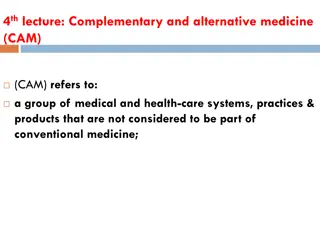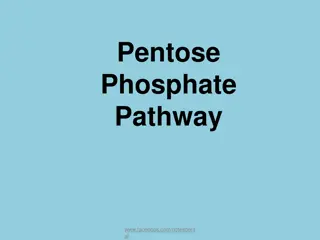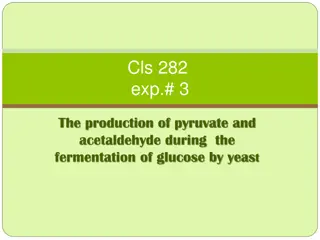Overview of HMP Shunt Pathway: An Anabolic Alternative to Glycolysis
The HMP shunt pathway, also known as the pentose phosphate pathway, plays a crucial role in glucose oxidation, NADPH biosynthesis, and pentose production. Located in the cytosol, it is active in various tissues for fatty acid and steroid biosynthesis. This multifunctional pathway involves both oxidative and non-oxidative phases, with key enzymatic reactions leading to the generation of NADPH and pentose sugars.
Download Presentation

Please find below an Image/Link to download the presentation.
The content on the website is provided AS IS for your information and personal use only. It may not be sold, licensed, or shared on other websites without obtaining consent from the author.If you encounter any issues during the download, it is possible that the publisher has removed the file from their server.
You are allowed to download the files provided on this website for personal or commercial use, subject to the condition that they are used lawfully. All files are the property of their respective owners.
The content on the website is provided AS IS for your information and personal use only. It may not be sold, licensed, or shared on other websites without obtaining consent from the author.
E N D
Presentation Transcript
HMP Shunt Or Pentose Phosphate Pathway
HMP pathway or HMP shunt is also called as pentose phosphate pathway or phosphogluconate pathway. HMP pathway is also known as lipman-warburg dickens pathway. This is an alternative pathway to glycolysis and TCA cycle for the oxidation ofglucose. HMP shunt is more anabolic innature.
It is concerned with the biosynthesis of NADPH & pentoses. About 10% of glucose entering in this pathway/day. The liver & RBC metabolise about 30% of glucose by this pathway.
Location of the pathway The enzymes are located in the cytosol. The tissues such as liver, adipose tissue, adrenal gland, erythrocytes, testes & lactating mammary gland, are highly active in HMPshunt. Most of these tissues are involved in biosynthesis of fatty acids and steroids which are dependent on the supply of NADPH.
HMP shunt-uniquemultifunctional pathway It starts with glucose 6-phosphate. No ATP is directly utilized or produced inHMP shunt It is multifunctional pathway, several interconvertible substances produced, which are proceed in different directions in the metabolic reactions
Reactions of the pathway Reactions of the pathway: Divided into Two phases oxidative & non oxidative. Oxidative phase Step:1 Glucose 6- phosphate is oxidised by NADP- dependent Glucose 6- phosphate dehydrogenase (G6PD), 6- phosphogluconolactone is formed. NADPH is formed in this reaction and this is a rate limiting step.
Step:2 6-phosphogluconolactone is hydrolysed by glucono lactone hydrolase to form 6-phosphogluconate. Step : 3 The next reaction involving the synthesis of NADPH and is catalysed by 6 phosphogluconate dehydrogenase to produce 3 keto 6 phosphogluconate which then undergoes decarboxylation to give ribulose 5 phosphate.
Non-Oxidative Phase Step: 4 The ribulose -5-phosphate is then isomerized to ribose -5-phosphate or epimerised to xylulose -5- phosphate Step: 5 Transketolase reaction Transketolase is a thiamine pyrophosphate (TPP) dependent enzyme.
It transfers two-carbon unit from xylulose 5- phosphate to ribose 5-phosphate to form a 7- carbon sugar, sedoheptulose 7-phosphate and glyceraldehyde 3 phosphate.
Step: 6 Transaldolase reaction Transaldolase brings about the transfer of a 3 carbon fragment from sedoheptulose 7-phosphate to glyceraldehyde 3-phosphate to give fructose 6- phosphate & 4 carbon erythrose 4 phosphate.
Step: 7 Second transketolase Reaction In another transketolase reaction a 2 carbon unit is transferred from xylulose 5 phosphate to erythrose 4 phosphate to form fructose 6 phosphate & glyceraldehyde 3 phosphate. Fructose 6 phosphate & glyceraldehyde 3 phosphate are further metabolized by glycolysis & TCAcycle.
HMP-Shunt pathway Glucose 6-phosphate NADP+ Glucose6P- dehydrogenase Mg+2 NADPH + H+ 6-phosphoglucanolactone Glucanolactone hydrolase 6-phosphogluconate NADP+ Phosphogluconate dehydrogenase Mg+2 CO2, NADPH + H+ Ribulose 5-phosphate
Ribulose 5-phosphate Xylulose 5-phosphate Fructose6- Phosphate Xylulose 5-phosphate Ribose 5-phosphate Transketolase, TPP Transketolase, TPP Sedoheptolose7- phosphate Glyceraldehyde 3- phosphate Glyceraldehyde 3- phosphate Transaldolase Erythrose 4- Phosphate Fructose 6- Phosphate Fructose6- Phosphate
Significance of HMPShunt HMP shunt is unique in generating two importantproducts- pentoses and NADPH Importance of pentoses: In HMP shunt, hexoses are converted into pentoses,the most important being ribose 5 phosphate. This pentose or its derivatives are useful for the synthesis of nucleic acids (DNA &RNA) Many nucleotides such as ATP, NAD+, FAD & CoA
Importance of NADPH NADPH is required for the bio synthesis of fatty acids and steroids. NADPH is used in the synthesis of certain amino acids involving the enzyme glutamate dehydrogenase. Free radical Scavenging The free radicals (super oxide, hydrogen peroxide) are continuously produced in all cells.
These will destroy DNA, proteins, fatty acids & all biomolecules & in turn cells are destroyed. The free radicals are inactivated by the enzyme systems containing SOD, POD & glutathione reductase. Reduced GSH is regenerated with the help of NADH.
Erythrocyte Membrane intigrity NADPH is required by the RBC to keep the glutathione in the reduced state. In turn, reduced glutathione will detoxify the peroxides & free radicals formed within the RBC. NADPH, glutathione & glutathione reductase together will preserve the intigrity of RBC membrane.
Prevention of Met-Hemoglobinemia NADPH is also required to keep the iron of hemoglobin in the reduced (ferrous) state & to prevent the accumulation of met-hemoglobin. Met-hemoglobin cannot carry the oxygen.
Detoxification of Drugs Most of the drugs and other foreign substances are detoxified by the liver microsomal P450 enzymes, with the help of NADPH. Lens of Eye: Maximum concentration of NADPH is seen in lens of eye. NADPH is required for preserving the transparency of lens.
Macrophage bactericidal activity: NADPH is required for the production of reactive oxygen species (ROS) by macrophases to kill bacteria. Availability of Ribose: Ribose & Deoxy ribose are required for DNA& RNAsynthesis.
Ribose is also necessary for nucleotide co enzymes. Reversal of non oxidative phase is present in all tissues, by which ribose could be made available. What aboutATP ATP is neither utilized nor produced by the HMP shunt. Cells do not use the shunt pathway for energy production.
Regulation of HMPShunt The entry of glucose 6-phosphate into the pentose phosphate pathway is controlled by the cellular concentration of NADPH NADPH is a strong inhibitor of glucose 6-phosphate dehydrogenase (G6PD) NADPH is used in various pathways, inhibition is relieved & the enzyme is accelerated to produce more NADPH
The synthesis of glucose 6-phosphate dehydrogenase is induced by the increased insulin/glucagon ratio after a high carbohydrate meal.
Glucose-6-phosphate dehydrogenase deficiency(G6PD) It is an inherited sex linked trait. It is more severe in RBC. Decreased activity of G6PD impairs the synthesis of NADPH in RBC. This results in the accumulation of meth hemoglobin & peroxides in erythrocytes leading to hemolysis.
The deficiency is manifested only when exposed to certain drugs or toxins, e.g.intake of antimalarial drug like primaquine & ingestion of fava beans(favism) & sulpha drugs also parecipitate the hemolysis
Some patients developed severe symptoms Jaundice, decrease in Hb, destruction of RBCs. In deficiency of G6PD, Hb can no longer be maintained inthe reduced form. Hb molecules then cross-link with one another to form aggregates called Heinz bodies on membranes. Membranes damaged by the Heinz bodies & ROS become Hemolytic anemia deformed & the cell undergos LYSIS
G6PD deficiency & malaria G6PD deficiency is associated with resistance to malaria (caused by plasmodium infection) The parasite requires reduced glutathione for its survival, which will not be available in adequate amounts in deficiency of G6PD. Met hemoglobinemia G6PD deficient persons will show increased Met hemoglobin in circulation, even though cyanosis may not be manifested.
Thiamine Deficiency The transketolase activity is measured in RBCs is an index of the thiamine status of an individual. The occurrence & manifestation of Wernickeskorsakoffs syndrome (encephalopathy) which is seen in alcoholics & those with thiamine deficiency is due to a genetic defect in the enzyme transketolase. The symptoms include mental disorder, loss of memory & partial paralysis.
